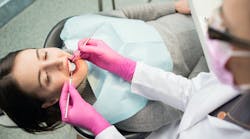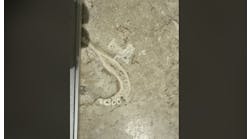No matter how long you’ve been a practicing dental hygienist, you’ve undoubtedly had a patient with dental anxiety. We put patients in a very vulnerable position when we lay them back in the chair. Then we ask them to “relax” while we work on an area of their body that’s often pretty foreign to them. They usually have a limited understanding of what we’re doing during treatment.
As providers, we feel a lot of pressure and anxiety to deliver quality care while handling an unending list of duties in what seems to be an ever-shrinking amount of time. There are several reasons why a dental office is an anxious setting. However, there is a major component of dental anxiety that needs to be discussed more: how airway resistance and breathing disorders impact a patient’s experience.
If a patient has airway resistance due to structural limitations such as enlarged tonsils, enlarged nasal turbinates, collapsed nasal valves, an elongated soft palate, or macroglossia, they’re living in a state of chronic fight-or-flight. These structural limitations decrease a patient’s ability to nasal breathe, which leads to mouth breathing. Mouth breathing has been proven by research to impact the nervous system, mood regulation, blood chemistry, and more.
You might also want to read: 5 tips to help intraoral exams serve as myofunctional airway screenings
The problems related to mouth breathing
Mouth breathing activates the sympathetic nervous system, or the stress response, and increases cortisol levels. It does this by creating shallow and rapid breathing patterns compared to the calming processes of nasal and diaphragmatic breathing. Mouth breathing also limits the production of nitric oxide, which is an important vasodilator and helps regulate blood pressure and heart rate variability.1
Essentially, mouth breathing increases blood pressure and heart rate, activates a systemic stress response, and increases breathing rate, all of which are linked to a heightened sense of anxiety. All of this can be happening to a patient before they even sit in your chair.
Imagine a patient with chronic mouth-breathing habits who has been living in a state of elevated anxiety and systemic dysregulation for months or years. Now, lay them back in your chair, talk to them about how oral pathogens impact their systemic health, add in a little water pooling in their mouth while they have no control over the suction, and ask them to nasal breathe through their restricted air passages. Talk about an anxiety-inducing experience! And that’s just for patients with mouth-breathing habits.
If we consider additional breathing disorders such as asthma, COPD, or upper airway resistance syndrome, this cycle of dysfunction increases and leads to more dental anxiety, avoidance of dental treatment, and ultimately, impaired systemic health. The prevalence of anxiety is 28% higher in those with asthma and 22% higher in those with COPD when compared to normal population control groups.2
This is also true in patients with sleep apnea. Chronic, repeated sleep disturbances lead to increased cortisol levels, decreased ability to cope with stress, hormonal imbalances, insulin resistance, and chronic fatigue. These all contribute to mood disorders such as anxiety, depression, PTSD, and more.3
According to Dorwart, “A growing body of evidence suggests that sleep apnea and anxiety are connected. It’s likely that each condition exacerbates the other: disturbed sleep due to sleep apnea can increase daytime stress and fatigue. Anxiety can also trigger and worsen sleep by making it harder to fall asleep at night.”4
How to spot an airway patient
As providers, identifying an airway patient is as simple as being aware of what the patient’s body is going through and what they’re experiencing while in your chair. They’re the ones who have the world’s strongest tongue, cheeks, and mentalis muscles. They cannot tolerate any form of an intraoral radiograph being taken on them. They’re the gaggers, the patients who are easily startled and flinch at the slightest sensation of touch.
Conversely, from the patient’s perspective, they’re subconsciously protecting their airways, and they’re in a state of fight-or-flight before they even walk into the operatory. They need just a little more of our time and energy to guide them through their emotional responses throughout their treatment visits.
The hardest part is that airway restrictions have no age limits. This cycle of dysfunction—airway restriction leading to dental anxiety leading to dental avoidance leading to poor oral and systemic health—can occur at any age. So, while it can be hard to work on certain patients, it’s important to remember the vulnerable position we put them in, especially if their airway is compromised.
It’s our job to treat all patients to the best of our abilities and knowledge and try to understand what they’re experiencing in our chairs. We need to work with them, not against them, in establishing habits and routines that help them build an optimal oral and systemic health foundation, all while reducing as much anxiety as we can while they’re in our care.
References
- Bryan NS. Nitric oxide deficiency is a primary driver of hypertension. Biochem Pharm. 2022;206. doi:10.1016/j.bcp.2022.115325
- Allam AH, Rawy AM, Abdeldayem OM, Mogahed MM, Abdelazeem E. Prevalence of anxiety and depression in patients with airway obstruction using hospital anxiety and depression scale (HADS) in different localities of Saudi Arabia. Egypt J Chest Dis Tubercul. 2017;66(4):617-622. doi:10.1016/j.ejcdt
- Kim TW, Jeong JH, Hong SC. The impact of sleep and circadian disturbance on hormones and metabolism. Int J Endocrinol. 2015;2015:591729. doi:10.1155/2015/591729
- Dorwart L. Sleep apnea and anxiety: Is there a connection? Verywell Health. February 27, 2022. https://www.verywellhealth.com/sleep-apnea-and-anxiety-5216472
Liz Laney, BSDH, RDH, OMT, has been active in the dental field since 2011 and has been practicing as an RDH since 2015, with additional training in airway dentistry and orofacial myofunctional therapy. She has experience and advanced education in several areas of dentistry, including infection control, dental hygiene policy and procedure creation and implementation, and periodontics. Reach her at [email protected]. To learn more and follow along with Liz's myofunctional therapy cases, check out her website at rootcauseresolutionsllc.com.






